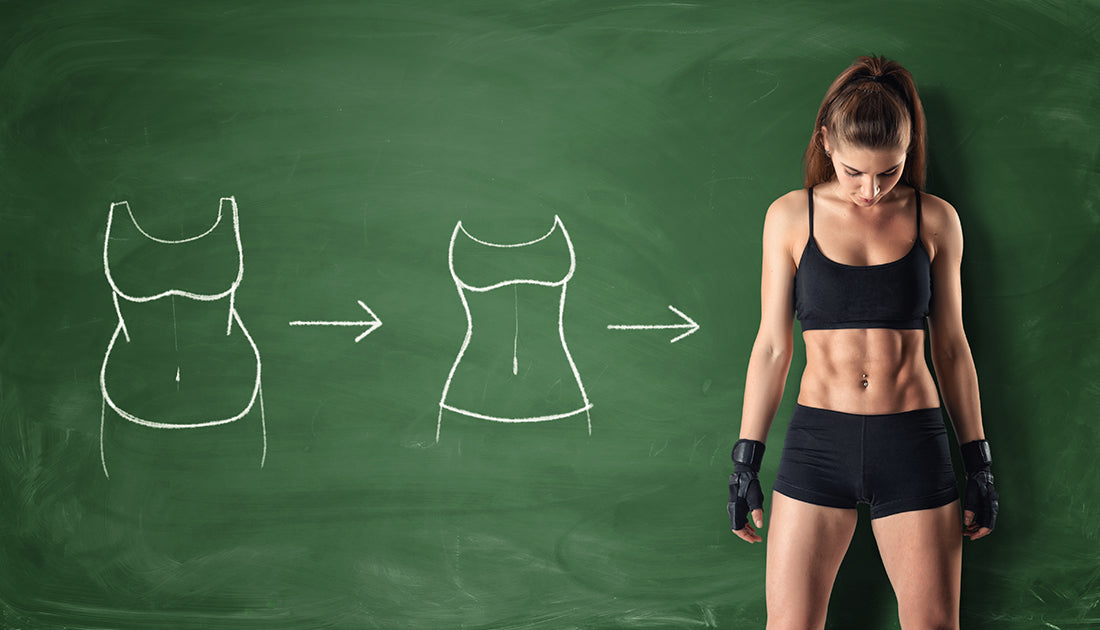Losing weight is challenging (but achievable) for many individuals. However, stubborn belly fat is one hurdle that even people who are easily able to lose weight struggle to lose.
Part of the reason for this is that you can't spot-reduce fat on the body to any meaningful degree. What we mean by that is that no matter how many crunches, sit-ups, or hanging leg raises do, you won't burn just the fat off your midsection.
Fat loss is a global process, meaning you really can’t choose from which area your body loses fat first. All you can really do is keep dieting until your body starts losing from the stubborn areas -- thighs, hips, buttocks, etc.
While belly fat certainly is annoying, there's a bigger concern at play as research indicates that central adiposity (i.e., belly fat) increases your risk for certain diseases, including heart disease and type 2 diabetes.
If you’ve struggled to lose fat before, here are some easy and effective strategies to effectively lose stubborn belly fat once and for all!
5 Easy and Effective Ways to Lose Stubborn Belly Fat
Up Your Protein Intake
There are many reasons that higher protein intakes are recommended, especially for individuals looking to improve their body composition (build muscle and lose fat).
For starters, consuming enough protein is essential to repairing and building muscle tissue since protein supplies the body with the essential amino acids (including the BCAAs). It needs to create proteins, which are then incorporated into muscle tissue.
Protein is also incredibly satiating, which means it helps keep you feeling fuller for longer compared to carbohydrates or fats. Experiencing less hunger and feeling fuller can help you avoid overeating and thereby staying within your calorie limits and losing weight.
Furthermore, several studies have also found that individuals who eat more protein tend to have less abdominal fat than those who eat a lower protein diet. <1,2,3>
Higher protein diets also help you retain muscle during a diet, which helps keep metabolism high and avoid the dreaded "skinny fat" look at the end of your diet.
Last but not least, protein requires more energy for your body to digest and breakdown than it does either carbohydrates or fats. This means that by eating a higher protein diet, compared to one higher in fats and/or carbs, your body burns more calories throughout the day, all the while feeling fewer hunger thanks to the high satiety rating of protein.
Some of our favorite protein sources to include when we’re trying to lose fat are:
- Lean Beef
- Chicken
- Turkey
- Fish
- Shellfish
- Whey Protein
Are You Eating Enough Soluble Fiber?
The real key to losing fat (even stubborn belly fat) is sticking to your diet. The reason many individuals struggle to stick to their diet is that they constantly feel hungry.
Consuming enough protein will help keep hunger in check to a certain degree, but another way to avoid feeling hungry in between meals is to make sure you’re consuming enough fiber.
Fiber is the indigestible portion of plant foods, meaning our bodies cannot break them down for energy. However, fiber does serve a few important purposes.
For starters, it adds volume and takes up space in the stomach and digestive tract, which helps expand the stomach and slow the rate of digestion, both of which help keep you feeling full.
By slowing down the speed of digestion, fiber also supports a steady release of energy into the bloodstream, which helps prevent energy highs and lows and cravings.
Lastly, fiber also serves as an important source of fuel for the bacteria lining our GI tract walls. The bacteria in our gut also release proteins that are linked to feelings of satiety. <4>
If that’s not enough reason to consider keeping an eye on your fiber intake, then consider this -- research has found that for every 10-gram increase in soluble fiber intake, belly fat gain decreased by 3.7% over a 5-year period! <5>
Foods rich in soluble fiber include:
- Black Beans
- Lima Beans
- Kidney Beans
- Oatmeal
- Avocado
- Carrots
You can also look into a soluble fiber supplement, like SteelFit® Sunfiber®, which provides 6 grams of natural soluble fiber from guar. Sunfiber also acts as a prebiotic that increases both Bifidobacteria and Lactobacillus levels in the gut, promoting gut health and appetite suppression.
Perform Resistance Training
While cardio has been the de facto form of exercise recommended for individuals looking to lose weight, the truth is that your training program's real focus should be on resistance training.
The reason for this is that cardio doesn't do much to build or maintain muscle mass. In case you weren't aware, dieting (which is needed to lose stubborn belly fat) places the body in a calorie deficit, increasing the risk for protein breakdown and muscle loss.
The two ways to combat muscle loss while dieting are to eat a high-protein diet (see above) and perform resistance training.
Resistance training (lifting weights, bodyweight exercise, resistance band workouts, etc.) provides a robust stimulus to your body, which tells it that it needs to hold onto its muscle. This forces your body to turn to your fat stores to make up the energy it's not getting from food.
The result is less body fat, more toned muscles, and a better overall physique.
Studies involving people with diabetes and those with fatty liver disease have found that resistance training may be beneficial for losing stubborn belly fat. <6>
Now, cardio can still be included in your weekly training program. It does help burn some extra calories, and there's some research to indicate that the combination of resistance training + cardio is most effective for losing weight. <7>
Practice Reducing Stress Levels
When we're stressed, the adrenal glands release the stress hormone cortisol.
In acute situations, such as an intense workout, cortisol is beneficial as it mobilizes energy and helps us perform at a high level.
However, when cortisol levels are chronically elevated (a situation many people are experiencing these days), our physiology kind of goes haywire.
Chronically elevated cortisol levels are known to <8,9>:
- Impair Sleep
- Disrupt Energy Metabolism
- Increase Appetite
- Reduce Satiety
- Promote Fat Storage (particularly around the abdomen)
- Decreases Mood and Feelings of Well-Being
To help reduce stress (and belly fat), engage in relaxing, enjoyable activities like walking through nature, exercising, yoga, meditation, reading, listening to relaxing music, etc.
Supplement Smart
The final piece of the puzzle to enhancing weight loss is supplementation. While supplements can’t make up for a poor diet, training, or sleep, they can improve and enhance results if the rest of the big picture items are taken care of.
When looking for the best fat burners for belly fat, we turn to Steel Core®.
Steel Core® is a stimulant-free thermogenic weight loss support aid that aids fat metabolism, helps reduce feelings of stress, and promotes a healthy metabolism.
References
- Loenneke JP, Wilson JM, Manninen AH, Wray ME, Barnes JT, Pujol TJ. Quality protein intake is inversely related with abdominal fat. Nutr Metab (Lond). 2012 Jan 27;9(1):5. DOI: 10.1186/1743-7075-9-5. PMID: 22284338; PMCID: PMC3284412.
- Merchant AT, Anand SS, Vuksan V, Jacobs R, Davis B, Teo K, Yusuf S; SHARE and SHARE-AP Investigators. Protein intake is inversely associated with abdominal obesity in a multi-ethnic population. J Nutr. 2005 May;135(5):1196-201. DOI: 10.1093/jn/135.5.1196. PMID: 15867303.
- Halkjaer J, Tjønneland A, Thomsen BL, Overvad K, Sørensen TI. Intake of macronutrients as predictors of 5-y changes in waist circumference. Am J Clin Nutr. 2006 Oct;84(4):789-97. DOI: 10.1093/ajcn/84.4.789. PMID: 17023705.
- Breton, J., Tennoune, N., Lucas, N., Francois, M., Legrand, R., Jacquemot, J., Goichon, A., Guérin, C., Peltier, J., Pestel-Caron, M., Chan, P., Vaudry, D., Do Rego, J., Liénard, F., Pénicaud, L., Fioramonti, X., Ebenezer, I., Hökfelt, T., Déchelotte, P., … Fetissov, S. (2016). Gut commensal E. coli proteins activate host satiety pathways following nutrient-induced bacterial growth. Cell Metabolism, 23(2), 324-334. https://doi.org/10.1016/j.cmet.2015.10.017
- Hairston KG, Vitolins MZ, Norris JM, Anderson AM, Hanley AJ, Wagenknecht LE. Lifestyle factors and 5-year abdominal fat accumulation in a minority cohort: the IRAS Family Study. Obesity (Silver Spring). 2012;20(2):421-427. doi:10.1038/oby.2011.171
- Dutheil F, Lac G, Lesourd B, Chapter R, Walther G, Vinet A, Sapin V, Verney J, Ouchchane L, Duclos M, Obert P, Courteix D. Different modalities of exercise to reduce visceral fat mass and cardiovascular risk in metabolic syndrome: the RESOLVE randomized trial. Int J Cardiol. 2013 Oct 9;168(4):3634-42. DOI: 10.1016/j.ijcard.2013.05.012. Epub 2013 May 25. PMID: 23714599.
- Dâmaso AR, da Silveira Campos RM, Caranti DA, de Piano A, Fisberg M, Foschini D, de Lima Sanches P, Tock L, Lederman HM, Tufik S, de Mello MT. Aerobic plus resistance training was more effective in improving the visceral adiposity, metabolic profile and inflammatory markers than aerobic training in obese adolescents. J Sports Sci. 2014;32(15):1435-45. DOI: 10.1080/02640414.2014.900692. Epub 2014 Apr 14. PMID: 24730354.
- Dallman MF, la Fleur SE, Pecoraro NC, Gomez F, Houshyar H, Akana SF. Minireview: glucocorticoids--food intake, abdominal obesity, and wealthy nations in 2004. Endocrinology. 2004 Jun;145(6):2633-8. DOI: 10.1210/en.2004-0037. Epub 2004 Mar 24. PMID: 15044359.
- Warne JP. Shaping the stress response: interplay of palatable food choices, glucocorticoids, insulin, and abdominal obesity. Mol Cell Endocrinol. 2009 Mar 5;300(1-2):137-46. DOI: 10.1016/j.mce.2008.09.036. Epub 2008 Oct 15. PMID: 18984030.

